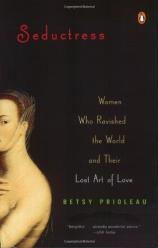Reading Group Guide
Discussion Questions
Seductress: Women Who Ravished the World and Their Lost Art of Love

1. Why do you think ancient patriarchal cultures like Sumer and Athenian Greece tolerated such unruly sex goddesses?
2. Why do you think ancient patriarchal cultures like Sumer and Athenian Greece tolerated such unruly sex goddesses?
3. Pick two seductresses at random—Lola Montez and Minette Helvetius, for example—and analyze how they did it, using the Art of Love precepts in chapter one. What did they leave out? Contrast the two approaches.
4. Many of the seductresses in the book were androgynous—unfeminine types with male interests and qualities. Discuss this paradox. What makes "masculine" women seductive and why?
5. The philosopher Soren Kierkegaard thought seduction necessary for all worldly enterprises. "A man who cannot seduce men," he said, "cannot save them either." How useful is this for women in the workplace? Can women deploy some of these erotic strategies nonsexually as Elizabeth I and Catherine the Great did to lead more effectively? Where does this shade into sexual harassment?
6. From the beginning, mainstream Feminism has been antagonistic to sexually successful women. Examine this phenomenon. Explore the puritan roots in the movement and the issue of sexual rivalry.
7. Some civilizations are more receptive to the seductress than others. For example, a disproportionate number of seductresses in the book are French, a culture steeped in sexism. How is America either good or bad for seductresses? Why?
8. Conversation is one of the most consistent and powerful aphrodisiacs used by the great seductresses. What were the components of their conversational magic? Can we retrieve them today? How?
9. Based on the stories of history's top enchantresses, construct a twenty-first-century master plan to recoup female romantic primacy in an age of online dating, hook-up/break-up relationships, beautymania, and the banalization of sex and love.
10. Who are the seductresses today? What are their chief allures and strengths as contrasted with those of the past? What are the barriers now preventing women from being seductresses?
11. If seductresses are such exemplary women, why were they demonized through the ages? If men loved them so much, why did they persecute them, and why did women join them?
12.Compare and contrast two opposite seductresses, such as Lou Andreas Salomé who wore no makeup and discussed philosophy and Cora Pearl who overdressed and traded in jokes and small talk. What qualities do they share in common?
13. Seductresses are known by their ability to get and keep the best men. Define this "best" man. What do women really want in a mate? Once we have sexual choice, do we choose well or poorly like Wallis Simpson?
14. Many of the seductresses suffered persecution and/or social exclusion. What are the qualities necessary to survive as a seductress, faced with prejudice, envy, and the spite of lesser men?
15. Discuss the role of media, popular culture, compulsory education, and religious or moral indoctrination today with respect to female sexual autonomy and power.
16. Men for all of recorded history have been perceived as the stronger, sexier sex. Examine the truth of this belief in the light of the stories of the seductresses.
17. Can you track any changes in seductresses over the centuries? If so, can you spot any constants in the personalities and strategies of these mancharmers? Are women as seductive now as in the past?
Seductress: Women Who Ravished the World and Their Lost Art of Love
- Publication Date: October 26, 2004
- Paperback: 384 pages
- Publisher: Penguin (Non-Classics)
- ISBN-10: 0143034227
- ISBN-13: 9780143034223








